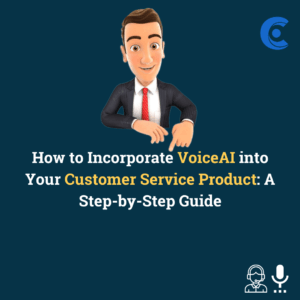How to Incorporate VoiceAI into Your Customer Service Product: A Step-by-Step Guide

Step 1: Define your objectives
Before diving into the technical implementation, clearly define your objectives and understand how VoiceAI can benefit your customer service product. Consider the specific problems you want to solve, such as reducing call wait times, automating repetitive tasks, or providing more accurate responses.
Step 2: Choose the right VoiceAI platform
Research VoiceAI platforms with ASR, NLU, TTS, and integration capabilities. Popular options: Google Cloud Speech-to-Text, IBM Watson, Microsoft Azure Speech Services, and Amazon Transcribe.
Step 3: Design Conversational Flows
Create a blueprint for your conversational flows to guide the VoiceAI implementation process. Identify the different user intents, possible dialogues, and decision trees. Determine how the VoiceAI system will interact with your existing backend systems and databases to retrieve and update relevant customer information.
Step 4: Collect & Annotate Training Data
Training your VoiceAI system requires a large amount of labeled data. Collect audio recordings of customer interactions and transcribe them, mapping the transcriptions to the corresponding user intents and outcomes. This annotated data will serve as the foundation for training your VoiceAI models.
Step 5: Train VoiceAI models
Using the collected and annotated data, train your VoiceAI models. This process involves training ASR models to convert speech to text, NLU models to understand user intents, and TTS models to generate natural-sounding responses. Depending on the chosen platform, you may have access to pre-trained models that can be fine-tuned for your specific use case.
Step 6: Implement VoiceAI integration
Integrate the VoiceAI platform into your customer service product. This involves making API calls to the VoiceAI platform for speech recognition & natural language understanding. Design your system to handle both input (user queries) and output (system responses) in a voice-based format.
Step 7: Handle Complex Scenarios
Train VoiceAI to handle complex scenarios, and ambiguous queries, provide accurate responses, handle misunderstandings/errors, and escalate to human agents when needed.
Step 8: Perform Rigorous Testing
Thoroughly test VoiceAI integration to meet quality standards. Conduct functional and user acceptance testing for accurate understanding and relevant responses. Iterate and refine models based on user feedback.
Step 9: Monitor and Improve Performance
Monitor VoiceAI performance with user feedback, call logs, and satisfaction metrics. Identify areas for improvement, fine-tune models, and stay updated with VoiceAI advancements.
Are you an expert on VoiceAI? Please share your valuable opinion
